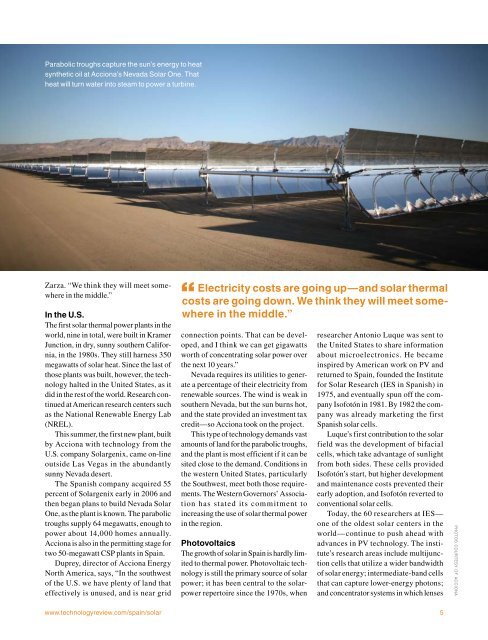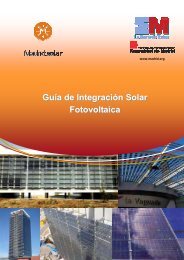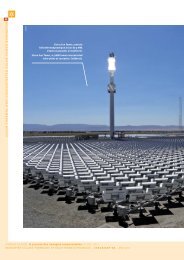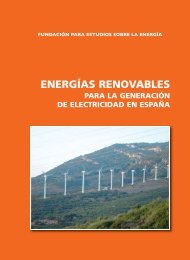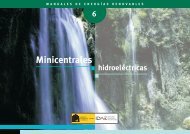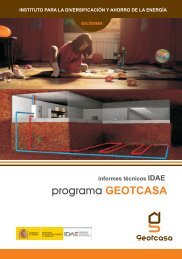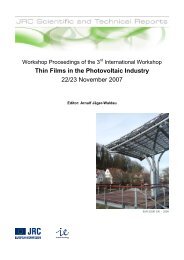New Technologies in Spain - Technology Review
New Technologies in Spain - Technology Review
New Technologies in Spain - Technology Review
Create successful ePaper yourself
Turn your PDF publications into a flip-book with our unique Google optimized e-Paper software.
Parabolic troughs capture the sun’s energy to heat<br />
synthetic oil at Acciona’s Nevada Solar One. That<br />
heat will turn water <strong>in</strong>to steam to power a turb<strong>in</strong>e.<br />
Zarza. “We th<strong>in</strong>k they will meet somewhere<br />
<strong>in</strong> the middle.”<br />
In the U.S.<br />
The first solar thermal power plants <strong>in</strong> the<br />
world, n<strong>in</strong>e <strong>in</strong> total, were built <strong>in</strong> Kramer<br />
Junction, <strong>in</strong> dry, sunny southern California,<br />
<strong>in</strong> the 1980s. They still harness 350<br />
megawatts of solar heat. S<strong>in</strong>ce the last of<br />
those plants was built, however, the technology<br />
halted <strong>in</strong> the United States, as it<br />
did <strong>in</strong> the rest of the world. Research cont<strong>in</strong>ued<br />
at American research centers such<br />
as the National Renewable Energy Lab<br />
(NREL).<br />
This summer, the first new plant, built<br />
by Acciona with technology from the<br />
U.S. company Solargenix, came on-l<strong>in</strong>e<br />
outside Las Vegas <strong>in</strong> the abundantly<br />
sunny Nevada desert.<br />
The Spanish company acquired 55<br />
percent of Solargenix early <strong>in</strong> 2006 and<br />
then began plans to build Nevada Solar<br />
One, as the plant is known. The parabolic<br />
troughs supply 64 megawatts, enough to<br />
power about 14,000 homes annually.<br />
Acciona is also <strong>in</strong> the permitt<strong>in</strong>g stage for<br />
two 50-megawatt CSP plants <strong>in</strong> Spa<strong>in</strong>.<br />
Duprey, director of Acciona Energy<br />
North America, says, “In the southwest<br />
of the U.S. we have plenty of land that<br />
effectively is unused, and is near grid<br />
“<br />
Electricity costs are go<strong>in</strong>g up—and solar thermal<br />
costs are go<strong>in</strong>g down. We th<strong>in</strong>k they will meet somewhere<br />
<strong>in</strong> the middle.”<br />
connection po<strong>in</strong>ts. That can be developed,<br />
and I th<strong>in</strong>k we can get gigawatts<br />
worth of concentrat<strong>in</strong>g solar power over<br />
the next 10 years.”<br />
Nevada requires its utilities to generate<br />
a percentage of their electricity from<br />
renewable sources. The w<strong>in</strong>d is weak <strong>in</strong><br />
southern Nevada, but the sun burns hot,<br />
and the state provided an <strong>in</strong>vestment tax<br />
credit—so Acciona took on the project.<br />
This type of technology demands vast<br />
amounts of land for the parabolic troughs,<br />
and the plant is most efficient if it can be<br />
sited close to the demand. Conditions <strong>in</strong><br />
the western United States, particularly<br />
the Southwest, meet both those requirements.<br />
The Western Governors’ Association<br />
has stated its commitment to<br />
<strong>in</strong>creas<strong>in</strong>g the use of solar thermal power<br />
<strong>in</strong> the region.<br />
Photovoltaics<br />
The growth of solar <strong>in</strong> Spa<strong>in</strong> is hardly limited<br />
to thermal power. Photovoltaic technology<br />
is still the primary source of solar<br />
power; it has been central to the solarpower<br />
repertoire s<strong>in</strong>ce the 1970s, when<br />
researcher Antonio Luque was sent to<br />
the United States to share <strong>in</strong>formation<br />
about microelectronics. He became<br />
<strong>in</strong>spired by American work on PV and<br />
returned to Spa<strong>in</strong>, founded the Institute<br />
for Solar Research (IES <strong>in</strong> Spanish) <strong>in</strong><br />
1975, and eventually spun off the company<br />
Isofotón <strong>in</strong> 1981. By 1982 the company<br />
was already market<strong>in</strong>g the first<br />
Spanish solar cells.<br />
Luque’s first contribution to the solar<br />
field was the development of bifacial<br />
cells, which take advantage of sunlight<br />
from both sides. These cells provided<br />
Isofotón’s start, but higher development<br />
and ma<strong>in</strong>tenance costs prevented their<br />
early adoption, and Isofotón reverted to<br />
conventional solar cells.<br />
Today, the 60 researchers at IES—<br />
one of the oldest solar centers <strong>in</strong> the<br />
world—cont<strong>in</strong>ue to push ahead with<br />
advances <strong>in</strong> PV technology. The <strong>in</strong>stitute’s<br />
research areas <strong>in</strong>clude multijunction<br />
cells that utilize a wider bandwidth<br />
of solar energy; <strong>in</strong>termediate -band cells<br />
that can capture lower-energy photons;<br />
and concentrator systems <strong>in</strong> which lenses<br />
p h o t o s c o u r t e s y o f ac c i o n a<br />
www.technologyreview.com/spa<strong>in</strong>/solar 5


